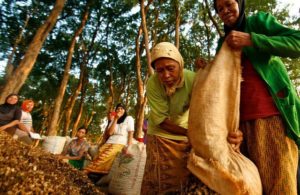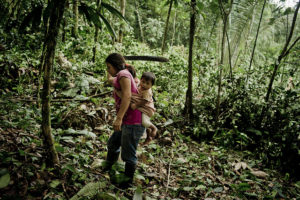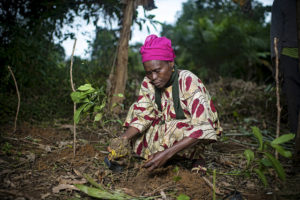
By Markus Ihalainen, originally published on CIFOR’s Forests News
Thanks to lobbying efforts by gender equality advocacy groups, the recent climate talks in Marrakesh yielded a significant decision that extended the mandate of the Lima Work Program on Gender (LWPG) over the next three years.
The two-year work program – first adopted at COP20 in Lima – contains a two-fold objective of: 1) Enhancing the gender-balance in the negotiations and 2) Providing guidance to Parties on gender-responsive climate policy.
Actions under the program included trainings for delegates on gender-responsive climate policy, capacity building for women delegates, and developing guidelines for implementing gender considerations in climate change activities.
While the extent to which the LWPG has achieved its objectives is debatable, it has opened up a space for more specific discussions and recommendations with respect to enhancing the gender-responsiveness of various policies and mechanisms under the UNFCCC. The decision to extend the mandate of the work program was thus received with much appreciation by gender equality advocates at COP22.
Here’s a look at some key dimensions of this decision in the context of the broader debates around gender and climate change.

ALIGNING CLIMATE POLICY WITH COMMITMENTS
One of the criticisms of the previous iteration of the LWPG is that despite its mandate, it “failed to articulate work on gender-responsive climate policy in relation to broader international obligations to human rights and gender equality”. This, in turn, allowed for a fair amount of confusion with respect to what ‘gender-responsive climate policy’ actually means.
It is thus positive that the preamble to the new decision maintains the ‘importance of coherence between gender-responsive climate policies … and the provisions of international instruments and outcomes’, including the Beijing Declaration, the Convention of Elimination of All Forms of Discrimination Against Women, and now the Sustainable Development Goals (SDGs).
What this text actually means for policy design, implementation and monitoring remains unclear. It is, however, essential that the above provision guide the work under the new iteration of the LWPG, as it opens up a crucial space for conceptualizing the role of gender equality and women’s empowerment in climate policy and action in a much broader sense.
Instead of viewing empowerment or equality as a vehicle for achieving other policy objectives, this framing allows us to flip things around and look at how various policies can impact equality or empowerment across a much wider set of political, economic, social and cultural indicators.
As such, this ‘rights-based’ framing departs from popular ‘business case’ arguments, which assert that women’s empowerment will lead to better economic, environmental or social outcomes. A rights-based argument does not ignore women’s contributions to promoting development and conservation; however, it does not make the granting of rights contingent on how effectively women contribute to the latter.
A strong rights-based framework is especially important now that policies and programs are increasingly aligning themselves to the SDG framework. Anchoring ‘women’s empowerment’ in broader international conventions could help mitigate the unfortunate tendency to water down empowerment to tokenistic participation in meetings simply to allow policies and programs to ‘hit as many SDGs as possible’.
Instead of simply assuming win-wins between social, economic and environmental objectives, a rights-based approach also allows us to have a much clearer and more honest conversation about leveraging synergies – as well as reconciling potential tensions – between the different SDGs.

FROM GLOBAL PLEDGES TO NATIONAL ACTION
In addition to a continued mandate, the new decision also requests the Subsidiary Body for Implementation (SBI) to ‘develop a gender action plan in order to support the implementation of gender-related decisions and mandates under the UNFCCC process’.
While the development of a gender action plan under the UNFCCC was not a given, it follows the trajectory of the other Rio conventions, which already have such plans in place. The priority areas for the action plan still needs to be defined, but this decision invites Parties, observers and other stakeholders to provide inputs to the formulation of the action plan.
A collaboratively developed, comprehensive Gender Action Plan (GAP) could prove useful for coordinating the efforts of various bodies and stakeholders, channeling funding towards specific actions outlined under the GAP, and for developing salient indicators for evaluating the gender-responsiveness of various climate policies.
However, it is important to note that the content of the GAP is to be defined over the coming year. So given the urgency of beginning the implementation of the Paris Agreement, the immediate priority in terms of gender equality in climate policy is still to ensure that all Parties to the Agreement take substantial actions on the national level towards safeguarding women’s rights and enhancing the gender-responsiveness of the climate policies and actions as outlined in the Intended Nationally Determined Contributions (INDCs).
This is particularly important given the fact that out of 188 INDCs submitted to the UNFCCC Secretariat prior to COP21, only 63 submissions included specific references to women or gender. A closer look shows that these references are often very general and superficial, mostly just outlining women as ‘vulnerable populations’.
It is also noteworthy that all of the 63 INDCs mentioning ‘women’ or ‘gender’ came from developing countries. Despite high-flying rhetoric, there seems to be a tendency among donor countries to view gender-responsive climate policy mostly as a priority for developing countries.
Concerns are being raised over whether donor commitments to gender equality and women’s empowerment actually translate into concrete funding. A recent OECD DAC report estimated that investments in women’s economic empowerment remained unchanged in the period from 2007-2012, and represented only two percent of total bilateral aid. This is a significant concern, especially as many commitments in developing countries’ INDCs remain conditional on the availability of funding.
During a discussion forum on gender held at the 2016 Global Landscapes Forum, panelist Lorena Aguilar, Senior Advisor of the Gender Programme at the International Union for Conservation of Nature (IUCN), stated that 21 countries have developed specific climate change and gender action plans (ccGAP). Yet, she warned, a lack of funds is hindering many governments from implementing these plans.
To enhance the implementation of gender-responsive climate policies, it is thus crucial that the operating entities of the Financial Mechanism – including the Green Climate Fund and the Global Environment Facility – are held accountable vis-à-vis the gender policies that both entities now have in place.
It is reassuring that the COP22 decision requests financial entities to provide information on the ‘integration of gender consideration in all aspects of their work’. However, it contains no references to the allocation for financial resources towards the implementation of gender-responsive climate action. Issues around financial responsibilities, targets and accountabilities thus remain largely unresolved.
At the same GLF forum, Eleanor Blomstrom, Co-Director of the Women’s Environment and Development Organization (WEDO), stressed the need to improve gender-responsive tracking and monitoring of finance for enhancing – and enforcing – the implementation of gender-responsive climate policies at the national level.

CONNECTING POLICY FRAMEWORKS TO LOCAL REALITIES
While it is important to monitor what policies are in place and to track their implementation, it is arguably even more important to understand the impact of these policies on the lives of local women and men. Policy processes removed from local realities are less likely to yield transformative results on the ground.
CIFOR’s research shows that climate change vulnerability tends to be highly contextual and depends on various socioeconomic, cultural and environmental variables. Despite this, gender is still primarily tackled as a men-versus-women dichotomy in climate change studies, according to a recent CIFOR paper.
One of the key hopes of CIFOR gender experts at COP22 was thus to contribute to a more nuanced picture of gender and climate change. Understanding that the vulnerabilities and adaptive capacities of women and men are structured by various societal power relations – and not just by virtue of their sex – can help enhance the responsiveness of climate policies. In order to ensure everyone’s voice is heard, it is vital that such ‘intersectional’ thinking is translated into implementation processes and impact assessment tools and instruments.
This requires that the voices of local people be accounted for in policy processes, particularly when it comes to adaptation, says Houria Djoudi, a scientist at CIFOR who was a panelist at the GLF event. Women in impacted communities are not sitting around waiting for international agreements to come in place – they use various strategies to adapt to climate change every day. However, rural women often lack a voice in national policy processes. As a result, many locally grounded, potentially up-scalable adaptation and mitigation initiatives risk going unnoticed, or replaced by top-down, inflexible programmatic responses with little local ownership.
It is therefore good to see the new decision taken in Morocco encourage Parties to recognize the value of grassroots women’s participation in gender-responsive climate action at all levels.
However, much remains to be done to move beyond lip-service towards meaningfully integrating local-level action in national climate policy and action, and to ensure that adequate capacities and resources are in place at the national and sub-national levels to support and scale up successful initiatives.











